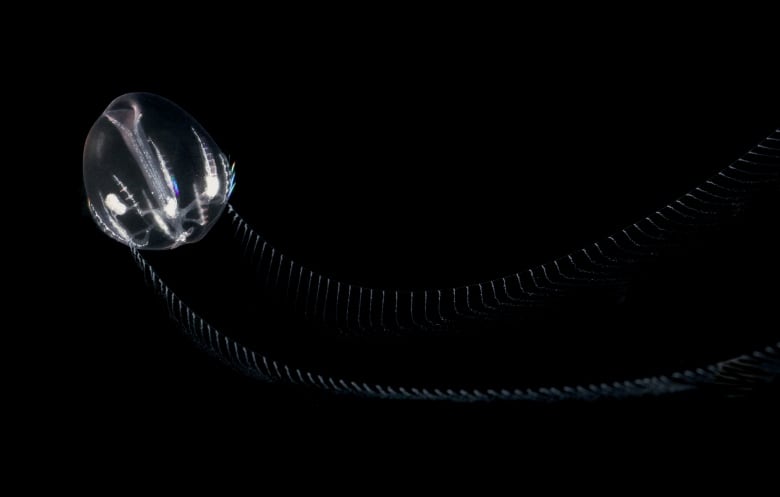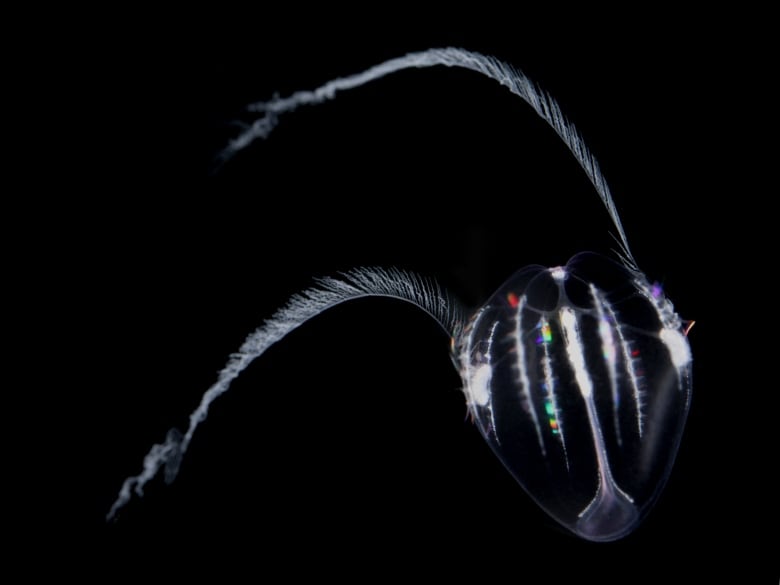
An invasive sea creature with a disappearing anus and a penchant for cannabalizing its own young may have yet another trick up its sleeve.
When life is going badly for the sea walnut, it will shrink and take on the shape of its larval form, and stay that way until things are looking up again, according to Norwegian researchers.
“We found that under certain conditions, these animals can basically go back in their life stage,” Pawel Burkhardt, an evolutionary biologist at the University of Bergen in Norway, told As It Happens guest host Susan Bonner.
“That was completely unknown for that group of species. It was a wonderful, wonderful finding.”
The study’s authors characterize this as “reverse development” — or, more simply, aging backwards. If they are correct, the sea walnut joins an elite group of organisms known to have this extremely rare ability, alongside Turritopsis dohrnii, a.k.a., the immortal jellyfish, and Echinococcus granulosus, a type of parasitic tapeworm.
But some scientists are critical of the study’s conclusions, saying the sea walnut’s ability to change its shape and size in response to external stimuli is already well-documented, and it doesn’t mean they can develop in reverse.
The findings were published this week in the pre-print journal BioRxiv and have not yet been peer-reviewed.
Responding to stress
Mnemiopsis leidyi, also known as a sea walnut or a warty comb jelly, is not a jellyfish, but rather a type of transparent, lobed marine invertebrate known as a ctenophore
“They live in the ocean and they look like walnuts, and have mesmerising light,” Burkhardt said. “Whenever you see them, you will remember this to the end of your life. It’s a beautiful, beautiful sight.”
They’re native to the Atlantic coasts, but have become an invasive species in the oceans of Europe and Asia, travelling the globe by hitching rides in the ballast tanks on ships.

To find out whether sea walnuts can undergo reverse development, Burkhardt and his colleague, marine biologist Joan Soto-Angel, subjected them to two key stressors: starvation and injury.
They withheld food from the comb jellies for two weeks, and performed lobectomies, meaning they cut off their gelatinous lobes. Burkhardt admits the methods seem harsh, but he says the sea walnuts experience similarly difficult conditions in the wild.
The hungry and hurt sea walnuts, he says, shrunk to roughly the size they were in their larval stage.
What’s more, 13 out of 65 of them grew pairs of tentacles, and used them to catch microscopic prey, something they normally only do in their larval state. As sea walnuts grow into adults, their tentacles shrink so much they become non-functional, and they instead use their lobes and other appendages to hunt.
“Basically, from an adult, they’re able to reverse to a younger stage,” Burkhardt said.
When the creatures were fed again, they returned to their usual size and shape.
Reverse development — or plain old metamorphosis?
Burkhardt says this ability might give the sea walnuts an evolutionary advantage, and help explain how they survive in ship ballast waters for weeks without food, and thrive in oceans around the world.
“If you’re a proper and big adult, you need lots of food. And if you have these conditions, you thrive in these condition, and you live like a happy big, big sea walnut. If you don’t, then you have to come up with a strategy, right?” he said.
“The sea walnut may have found a way to get smaller, to revert into a different, younger stage. And, at that time, they may be able to feed at much lower rates and thus survive harsh conditions.”
Jamileh Javidpour, who has studied sea walnuts but was not involved in this research, says she’s also seen the creatures shrink in the lab when food was unavailable, but the growth and use of larval tentacles makes these findings novel.
“These findings suggest that reverse development could play a crucial role in how marine organisms adapt to changing environments, particularly under the pressures of human activity,” Javidpour, an associate professor of ecology at the University of South Denmark, told CBC in an email.

But not everyone is convinced.
Mark Martindale, director of the Whitney Laboratory for Marine Bioscience in Florida, told CBC that anyone who has worked with comb jellies knows they can shrink and regenerate, so the study’s findings are “not that big a deal.”
Sidney Tamm, a biologist from Boston University who has studied the species, agrees.
“The regression of starved and lobectomized animals … is certainly not by reversal of developmental processes, and should not be called reverse development,” Tamm told CBC in an email.
Tamm says it would be more accurate to say the sea walnuts “regenerate and rearrange” themselves to “simulate” the shape of their larval form.
If the comb jellies were actually reverting to an earlier life stage, he says he would expect to see a reduction in the number of cilia, filament-like organelles, on parts of their bodies known as comb plates.
“The resulting phenotype may superficially look like a … larva, but it isn’t one,” he said. “So I think the authors are fooling themselves that what they see is due to reversal of development to an earlier stage in the life cycle.”
The authors, however, stand by their conclusions.
Soto-Angel says the sea walnuts in the study saw their comb plates reduce in number, and shrink in size. But the key piece of evidence, he says, is the growth and use of larval tentacles.
“Reverse development is about going back to the previous life cycle stage, and that is exactly what Mnemiopsis leidyi does,” he said.